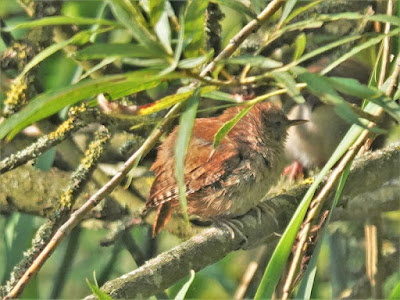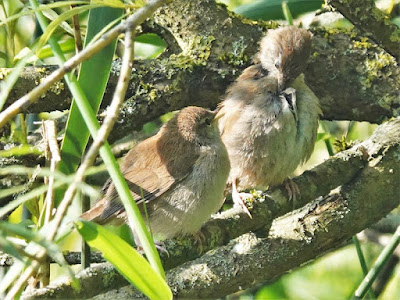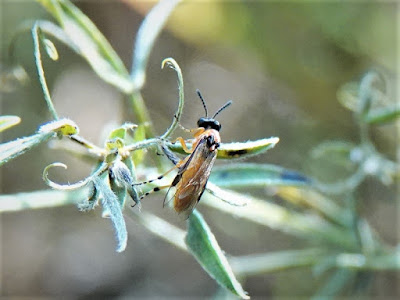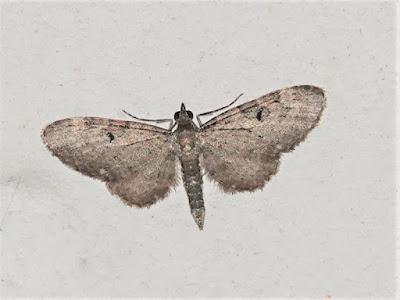11.0°C > 19.0°C: A few early high clouds soon dispersed then sunny. A calm start with a very light south-westerly breeze developing. Moderate to good visibility and hazy.
Sunrise: 05:19 BST
* = a species photographed today
$ = my first sighting of the species for this year
$$ = my first ever recorded sighting of the species in the area
Priorslee Balancing Lake: 05:00 – 06:20 // 07:30 – 09:45
(181st visit of the year)
Bird notes:
- apart from one Greylag Goose any overnighting geese had left before I arrived. Upon my return from The Flash geese were still arriving with eventually 66 Canada Geese and 14 Greylag Geese present.
- no obvious Mallard ducklings seen
- the duck Pochard was found again.
- a Tufted Duck, sex undetermined, briefly visited before flying off East.
- all seven juvenile Great Crested Grebes found. At least 10 adults noted.
- two Common Sandpipers noted
- a lone Blackbird still singing away.
- *at least four Cetti's Warblers were seen and heard along the North side. Proof of successful breeding here.
- a Common Whitethroat was heard alarm calling.
Bird(s) noted flying over here:
- 3 Canada Geese: outbound together
- 7 Greylag Geese: outbound together
- 1 Feral Pigeon: an all-white bird flew high East
- 81 Wood Pigeons
- 2 Lesser Black-baked Gulls
- 1 Grey Heron: as well as the two at the lake for a while
- 161 Jackdaws
- 70 Rooks
Counts from the lake area:
- 66 Canada Geese: see notes
- 14 Greylag Geese: see notes
- 2 Mute Swans
- 22 (?♂) Mallard: see notes
- 11+ 3 (2 dependent broods) Moorhens
- 104 Coots
- 10 + 7 (4 broods) Great Crested Grebes: see notes
- 2 Common Sandpipers
- 6 Black-headed Gulls only: no juveniles
- 2 Herring Gulls
- 3 Lesser Black-baked Gulls
- 2 Grey Herons: one chased away
Hirundines etc. noted:
- 3 Barn Swallows
- 1 House Martin
Warblers recorded (the figure in brackets is birds noted singing):
- *4 (0) Cetti's Warblers
- 11 (1) Chiffchaffs
- 4 (1) Reed Warblers
- 3 (0) Blackcaps
- 1 (0) Common Whitethroat
Noted on the West end street lamp poles around-dawn:
Moths:
none
none
Flies:
*1 long-legged fly Dolichopus sp., likely D. wahlbergi
*1 Tachinid fly Gastrolepta anthracina
*1 long-legged fly Dolichopus sp., likely D. wahlbergi
*1 Tachinid fly Gastrolepta anthracina
Spiders, harvestmen etc.:
1 harvestman Dicranopalpus ramosus/caudatus
Noted later:
Considering the sunny weather it seemed quiet for insects. Most flowers are now over so perhaps that is why:
1 harvestman Dicranopalpus ramosus/caudatus
Noted later:
Considering the sunny weather it seemed quiet for insects. Most flowers are now over so perhaps that is why:
Butterflies:
Large White Pieris brassicae
Small White Pieris rapae
Green-veined White Pieris napi
Speckled Wood Pararge aegeria
Gatekeeper Pyronia tithonus
Common Blue Polyommatus icarus
Large White Pieris brassicae
Small White Pieris rapae
Green-veined White Pieris napi
Speckled Wood Pararge aegeria
Gatekeeper Pyronia tithonus
Common Blue Polyommatus icarus
Moths
3 Straw Grass-moth Agriphila straminella [was Straw Grass-veneer]
5 unidentified grass moths, possibly all this species
*1 Mother of Pearl Patania ruralis [was Pleuroptya ruralis]
3 Straw Grass-moth Agriphila straminella [was Straw Grass-veneer]
5 unidentified grass moths, possibly all this species
*1 Mother of Pearl Patania ruralis [was Pleuroptya ruralis]
Bees, wasps etc.:
Red-tailed Bumblebee Bombus lapidarius
Common Carder Bee Bombus pascuorum
Buff-tailed Bumblebee Bombus terrestris
Common Wasp Paravespula vulgaris
*unidentified Crabonid wasp sp.
*Turnip Sawfly Athalia rosae
Red-tailed Bumblebee Bombus lapidarius
Common Carder Bee Bombus pascuorum
Buff-tailed Bumblebee Bombus terrestris
Common Wasp Paravespula vulgaris
*unidentified Crabonid wasp sp.
*Turnip Sawfly Athalia rosae
Hoverflies:
Bumblebee Blacklet Cheilosia illustrata
*Parsley Blacklet Cheilosia pagana
Marmalade Hoverfly Episyrphus balteatus
*$ Plain-faced Dronefly Eristalis arbustorum [Eurasian Drone Fly]
*Furry Dronefly Eristalis intricaria
Tapered Dronefly Eristalis pertinax
*Common Dronefly Eristalis tenax
Meadow Field Syrph Eupeodes latifasciatus [Broad-banded Aphideater]
Chequered Hoverfly Melanostoma scalare [Long-winged Duskyface]
Dead-head Hoverfly Myathropa florea [Common Batman Fly]
Syrphus sp. S. ribesii / S. vitripennis
Bumblebee Blacklet Cheilosia illustrata
*Parsley Blacklet Cheilosia pagana
Marmalade Hoverfly Episyrphus balteatus
*$ Plain-faced Dronefly Eristalis arbustorum [Eurasian Drone Fly]
*Furry Dronefly Eristalis intricaria
Tapered Dronefly Eristalis pertinax
*Common Dronefly Eristalis tenax
Meadow Field Syrph Eupeodes latifasciatus [Broad-banded Aphideater]
Chequered Hoverfly Melanostoma scalare [Long-winged Duskyface]
Dead-head Hoverfly Myathropa florea [Common Batman Fly]
Syrphus sp. S. ribesii / S. vitripennis
Dragon-/Damsel-flies:
Common Blue Damselfly Enallagma cyathigerum [Common Bluet]
*$ Common Darter Sympetrum striolatum
Hawker sp.
Common Blue Damselfly Enallagma cyathigerum [Common Bluet]
*$ Common Darter Sympetrum striolatum
Hawker sp.
Four-winged flies – Lacewings, Caddisflies etc.:
none
none
Other flies:
*$ Tachinid fly Phasia hemiptera
otherwise only unidentified fly species
*$ Tachinid fly Phasia hemiptera
otherwise only unidentified fly species
Bugs etc.:
none
none
Beetles:
7 Spot Ladybird Coccinella 7-punctata
Common Red Soldier Beetle Rhagonycha fulva
7 Spot Ladybird Coccinella 7-punctata
Common Red Soldier Beetle Rhagonycha fulva
Amphibians:
none
none
Spiders, harvestmen etc.:
money spider Erigone sp.
Zebra Spider Salticus scenicus
money spider Erigone sp.
Zebra Spider Salticus scenicus
New plants for the year:
*Lords & Ladies Arum maculatum [Cuckoo Pint]
My highlight of the day. One of three visible Cetti's Warblers with another calling nearby. These were, I am sure, a family group. I suspect this is a juvenile as although I cannot see a gape-line the bill is paler than it would be on an adult.
A typical view of a Mother of Pearl moth Patania ruralis. They do not like anyone standing behind them and quickly reposition.
This is a Turnip Sawfly Athalia rosae. Note the dark leading edge of the wings. It does not much like the one I photographed on Tuesday which was a brighter red. However that one also had the black shoulder-pads which are also a feature of this species.
The extensive white bands (of hairs) between the body-segments (tergites) help identify this hoverfly as a Plain-faced Dronefly Eristalis arbustorum which Obsidentify calls a Eurasian Drone Fly.
This moth is likely a Tawny Grey Eudonia lacustrata, a species that used to be known as Little Grey which was certainly a misnomer as without measuring it looks the same size and all the other species in this confusing group. I am not adding it to the confirmed sightings.
(177th visit of the year)
Bird notes:
- a dead Greylag Goose noted alongside the path. I could see no obvious sign of any injury.
- only five Mute Swans noted. A blue Darvic ring noted on one of them: hard to read at the distance - '7JXY' perhaps?'
- three juvenile Great Crested Grebes seen from the brood by the island. *The pair at the top end still had any young unseen on the back of one of the adults.
- two Grey Herons standing in trees at the top end
- my first Willow Warbler of the Autumn was heard singing, albeit briefly, at the top end.
Bird(s) noted flying over here:
- 1 Sparrowhawk
- 2 Jackdaws
Noted on / around the water:
- 29 Canada Geese
- 6 Greylag Geese: also a dead bird – see notes
- 6 Mute Swans
- 15 (?♂) Mallard
- 16 (?♂) Tufted Duck
- 8 Moorhens
- 104 + 8 (8 dependent broods) Coots: bright light to see those around the island
- *4 + >3 (2 broods) Great Crested Grebes: see notes
- 1 Black-headed Gull: juvenile arrived
- 2 Lesser Black-backed Gull: adults: one departed; another(?) visited briefly
- 2 Grey Herons
Hirundines etc. noted:
Moths:
1 probably the same probable Maple Pug! Eupithecia inturbata
*Lords & Ladies Arum maculatum [Cuckoo Pint]
My highlight of the day. One of three visible Cetti's Warblers with another calling nearby. These were, I am sure, a family group. I suspect this is a juvenile as although I cannot see a gape-line the bill is paler than it would be on an adult.
It did not help when this Wren appeared among the warblers.
A different Cetti's.
The same calling quietly. (I didn't know they did anything quietly)
Is it calling for food from a preening adult?
Last one. None of the other birds in the group would oblige.
A typical view of a Mother of Pearl moth Patania ruralis. They do not like anyone standing behind them and quickly reposition.
This is one of the Crabonid group of wasps. They cannot be specifically identified from photos.
A Parsley Blacklet hoverfly Cheilosia pagana
Not a bee (it has very short antennae) but a Furry Dronefly Eristalis intricaria. I have not seen any of these for some weeks. All those I saw earlier I recall as having rufous "tails". Apparently males can have rufous or white "tails" while females, as here, all have white "tails".
I noted a few days ago that I had not seen many Common Droneflies Eristalis tenax recently. Here is one!
My first Common Darter Sympetrum striolatum of the year. This could be a teneral (immature) male or a female. When adult males are red
On a street lamp pole around dawn was this long-legged fly from the Dolichopus genus, likely D. wahlbergi . This is a male with, as NatureSpot motes, "[its] mid tarsus modified into black pennate extensions, looking like a thick feather."
There were only two flies on the street lamp poles around dawn and this is the other. It seems to be the Tachinid fly Gastrolepta anthracina.
Another Tachinid fly this time Phasia hemiptera identified primarily by the orange hairs on the side of the thorax as well as its generally tubby shape.
Exposed by the mowing regime of the local council were these fruits of Lords & Ladies Arum maculatum also known as Cuckoo Pint. Do not eat the berries (or any other part of the plant either)! Highly toxic.
Aircraft of the day: this Robinson R44 Raven II is owned by Greenwood Louvre Ltd. of Pontyclun who, according to the internet, "promote healthy buildings through ventilation, smoke control and architectural louvres and solar shading". So there. It was flying South: the trace on FlightRadar24 is very intermittent due to its low altitude so I have no more information.
(Ed Wilson)
In the Priorslee Avenue tunnel:
I noted a few days ago that I had not seen many Common Droneflies Eristalis tenax recently. Here is one!
(Ed Wilson)
------------------------------------------------------------------------------------------------------
In the Priorslee Avenue tunnel:
Moths: [32 species here before today; cc confirmed addition]
*1 possible Tawny Grey Eudonia lacustrata [was Little Grey]
*1 White-spotted Pug Eupithecia tripuntaria : now confirmed
1 Single-dotted Wave Idaea dimidiata
*1 possible Tawny Grey Eudonia lacustrata [was Little Grey]
*1 White-spotted Pug Eupithecia tripuntaria : now confirmed
1 Single-dotted Wave Idaea dimidiata
Four-winged flies – Lacewings, Caddisflies etc.:
none
none
Flies:
4 moth flies Psychodidae sp. [Drain Fly or Owl Fly]
11 midges of various species.
4 moth flies Psychodidae sp. [Drain Fly or Owl Fly]
11 midges of various species.
Arthropods:
4 White-legged Snake Millipede Tachypodoiulus niger
4 White-legged Snake Millipede Tachypodoiulus niger
Spiders, harvestmen etc.:
2 Missing Sector Orb-web Spiders Zygiella x-notata [Silver-sided Sector Spider]
2 Missing Sector Orb-web Spiders Zygiella x-notata [Silver-sided Sector Spider]
This moth is likely a Tawny Grey Eudonia lacustrata, a species that used to be known as Little Grey which was certainly a misnomer as without measuring it looks the same size and all the other species in this confusing group. I am not adding it to the confirmed sightings.
A better photo today and I am now happy with Obsidentify's suggestion of White-spotted Pug Eupithecia tripuntaria.
(Ed Wilson)
The Flash: 06:25 – 07:25
(Ed Wilson)
------------------------------------------------------------------------------------------------------
The Flash: 06:25 – 07:25
(177th visit of the year)
Bird notes:
- a dead Greylag Goose noted alongside the path. I could see no obvious sign of any injury.
- only five Mute Swans noted. A blue Darvic ring noted on one of them: hard to read at the distance - '7JXY' perhaps?'
- three juvenile Great Crested Grebes seen from the brood by the island. *The pair at the top end still had any young unseen on the back of one of the adults.
- two Grey Herons standing in trees at the top end
- my first Willow Warbler of the Autumn was heard singing, albeit briefly, at the top end.
Bird(s) noted flying over here:
- 1 Sparrowhawk
- 2 Jackdaws
Noted on / around the water:
- 29 Canada Geese
- 6 Greylag Geese: also a dead bird – see notes
- 6 Mute Swans
- 15 (?♂) Mallard
- 16 (?♂) Tufted Duck
- 8 Moorhens
- 104 + 8 (8 dependent broods) Coots: bright light to see those around the island
- *4 + >3 (2 broods) Great Crested Grebes: see notes
- 1 Black-headed Gull: juvenile arrived
- 2 Lesser Black-backed Gull: adults: one departed; another(?) visited briefly
- 2 Grey Herons
Hirundines etc. noted:
None
Warblers recorded (the figure in brackets is birds noted singing):
- 1 (1) Willow Warbler
- 4 (2) Chiffchaffs
- 1 (1) Blackcap
Noted around the area:
Warblers recorded (the figure in brackets is birds noted singing):
- 1 (1) Willow Warbler
- 4 (2) Chiffchaffs
- 1 (1) Blackcap
Noted around the area:
Butterflies:
none
none
Moths [on street lamp poles and in the grass] [60 species here before today: no additions]
none
none
Bees, wasps etc.:
none
none
Hoverflies:
none
none
Dragon-/Damsel-flies:
none
none
Four-winged flies – Lacewings, Caddisflies etc.:
Grouse Wing caddis fly Mystacides longicornis
Grouse Wing caddis fly Mystacides longicornis
Other flies:
only unidentified fly species
only unidentified fly species
Bugs etc.:
none
none
Beetles:
none
none
Arthropods:
none
none
Spiders, harvestmen etc.:
2 harvestmen Dicranopalpus ramosus/caudatus
2 harvestmen Dicranopalpus ramosus/caudatus
New flowers for the year:
None
The pair of Great Crested Grebes from the top end. I am sure the bird on the right is harbouring juveniles under its raised back feathers. But how many?
(Ed Wilson)
A5 Telford Way Tunnel
The pair of Great Crested Grebes from the top end. I am sure the bird on the right is harbouring juveniles under its raised back feathers. But how many?
(Ed Wilson)
------------------------------------------------------------------------------------------------------
I made another visit to the tunnel at the top end which passes under the A5 Telford Way. Not worth going today!:
Moths:
1 probably the same probable Maple Pug! Eupithecia inturbata
(Ed Wilson)
2007
Priorslee Lake
Oystercatcher
300+ Lesser Black-backed Gulls
3 Herring Gulls
1 Yellow-legged Gull
1 Reed Warbler
3 Blackcaps
4 Chiffchaffs
4 Sand Martins
(Ed Wilson)
2006
Priorslee Lake
3 Great Crested Grebes
3 Herons
3 Greylag Geese
17 Tufted Ducks
1 Kestrel
6 Stock Doves
303 Wood Pigeons
12 Swifts
1 Kingfisher
4 Sand Martins
7 Swallows
6 House Martins
2 Grey Wagtails
8 Reed Warblers
2 Lesser Whitethroats
1 Common Whitethroat
1 Garden Warbler
9 Blackcaps
6 Chiffchaffs
2 Willow Warblers
3 Willow Tits
1 Jay
248 Jackdaws
485 Rooks
205 Greenfinches
3 Bullfinches
8 Reed Buntings
(Ed Wilson)
------------------------------------------------------------------------------------------------------
2007
Priorslee Lake
Oystercatcher
300+ Lesser Black-backed Gulls
3 Herring Gulls
1 Yellow-legged Gull
1 Reed Warbler
3 Blackcaps
4 Chiffchaffs
4 Sand Martins
(Ed Wilson)
2006
Priorslee Lake
3 Great Crested Grebes
3 Herons
3 Greylag Geese
17 Tufted Ducks
1 Kestrel
6 Stock Doves
303 Wood Pigeons
12 Swifts
1 Kingfisher
4 Sand Martins
7 Swallows
6 House Martins
2 Grey Wagtails
8 Reed Warblers
2 Lesser Whitethroats
1 Common Whitethroat
1 Garden Warbler
9 Blackcaps
6 Chiffchaffs
2 Willow Warblers
3 Willow Tits
1 Jay
248 Jackdaws
485 Rooks
205 Greenfinches
3 Bullfinches
8 Reed Buntings
(Ed Wilson)





















